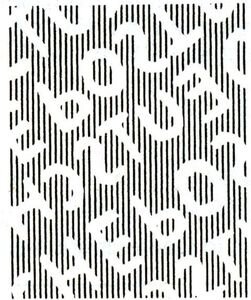Stamp: American-British-Soviet Occ. (Trizone) Mi: 968 - overprinted (Germany, Soviet Occupation (General Issues) 1948)
American-British-Soviet Occ. (Trizone) Mi: 968 - overprinted (Germany, Soviet Occupation (General Issues) 1948)
24 June (Germany, Soviet Occupation (General Issues) ) within release VII. District POTSDAM control number 36 goes into circulation Stamp American-British-Soviet Occ. (Trizone) Mi: 968 - overprinted face value 84 East German pfennig
| Stamp American-British-Soviet Occ. (Trizone) Mi: 968 - overprinted in catalogues | |
|---|---|
| Michel: | Mi: DD IIIdVII |
Stamp is horizontal format.
Overprint: 36 and city/town/village names of that districtAlso in the issue VII. District POTSDAM control number 36:
- Stamp - American-British-Soviet Occ. (Trizone) Mi: 915 - overprinted face value 5;
- Stamp - American-British-Soviet Occ. (Trizone) Mi: 916 - overprinted face value 6;
- Stamp - American-British-Soviet Occ. (Trizone) Mi: 917 - overprinted face value 8;
- Stamp - American-British-Soviet Occ. (Trizone) Mi: 918 - overprinted face value 10;
- Stamp - American-British-Soviet Occ. (Trizone) Mi: 920 - overprinted face value 12;
- Stamp - American-British-Soviet Occ. (Trizone) Mi: 921 - overprinted face value 15;
- Stamp - American-British-Soviet Occ. (Trizone) Mi: 922 - overprinted face value 15;
- Stamp - American-British-Soviet Occ. (Trizone) Mi: 923 - overprinted face value 16;
- Stamp - American-British-Soviet Occ. (Trizone) Mi: 924 - overprinted face value 20;
- Stamp - American-British-Soviet Occ. (Trizone) Mi: 925 - overprinted face value 24;
- Stamp - American-British-Soviet Occ. (Trizone) Mi: 927 - overprinted face value 25;
- Stamp - American-British-Soviet Occ. (Trizone) Mi: 928 - overprinted face value 30;
- Stamp - American-British-Soviet Occ. (Trizone) Mi: 929 - overprinted face value 40;
- Stamp - American-British-Soviet Occ. (Trizone) Mi: 931 - overprinted face value 45;
- Stamp - American-British-Soviet Occ. (Trizone) Mi: 932 - overprinted face value 50;
- Stamp - American-British-Soviet Occ. (Trizone) Mi: 933 - overprinted face value 60;
- Stamp - American-British-Soviet Occ. (Trizone) Mi: 934 - overprinted face value 75;
- Stamp - American-British-Soviet Occ. (Trizone) Mi: 935 - overprinted face value 80;
- Stamp - American-British-Soviet Occ. (Trizone) Mi: 936 - overprinted face value 84;
- Stamp - American-British-Soviet Occ. (Trizone) Mi: 937 - overprinted face value 1;
- Stamp - American-British-Soviet Occ. (Trizone) Mi: 943 - overprinted face value 2;
- Stamp - American-British-Soviet Occ. (Trizone) Mi: 944 - overprinted face value 6;
- Stamp - American-British-Soviet Occ. (Trizone) Mi: 945 - overprinted face value 8;
- Stamp - American-British-Soviet Occ. (Trizone) Mi: 946 - overprinted face value 10;
- Stamp - American-British-Soviet Occ. (Trizone) Mi: 947 - overprinted face value 12;
- Stamp - American-British-Soviet Occ. (Trizone) Mi: 948 - overprinted face value 15;
- Stamp - American-British-Soviet Occ. (Trizone) Mi: 949 - overprinted face value 16;
- Stamp - American-British-Soviet Occ. (Trizone) Mi: 950 - overprinted face value 20;
- Stamp - American-British-Soviet Occ. (Trizone) Mi: 951 - overprinted face value 24;
- Stamp - American-British-Soviet Occ. (Trizone) Mi: 952 - overprinted face value 25;
- Stamp - American-British-Soviet Occ. (Trizone) Mi: 953 - overprinted face value 30;
- Stamp - American-British-Soviet Occ. (Trizone) Mi: 955 - overprinted face value 50;
- Stamp - American-British-Soviet Occ. (Trizone) Mi: 956 - overprinted face value 60;
- Stamp - American-British-Soviet Occ. (Trizone) Mi: 957 - overprinted face value 80;
- Stamp - American-British-Soviet Occ. (Trizone) Mi: 958 - overprinted face value 84;
- Stamp - American-British-Soviet Occ. (Trizone) Mi: 960 - overprinted face value 2;
- Stamp - American-British-Soviet Occ. (Trizone) Mi: 961 - overprinted face value 3;
- Stamp - American-British-Soviet Occ. (Trizone) Mi: 967 - overprinted face value 50;
- Stamp - American-British-Soviet Occ. (Trizone) Mi: 968 - overprinted face value 84;
- Stamp - American-British-Soviet Occ. (Trizone) Mi: 969 - overprinted face value 24;
- Stamp - American-British-Soviet Occ. (Trizone) Mi: 970 - overprinted face value 50;
- Stamp - American-British-Soviet Occ. (Trizone) Mi:959a - overprinted face value 1;
- Stamp - American-British-Soviet Occ. (Trizone) Mi:962a - overprinted face value 5;
- Stamp - American-British-Soviet Occ. (Trizone) Mi:963a - overprinted face value 24;
- Stamp - American-British-Soviet Occ. (Trizone) Mi:963b - overprinted face value 24;
- Stamp - American-British-Soviet Occ. (Trizone) Mi:964a - overprinted face value 75;
- Stamp - American-British-Soviet Occ. (Trizone) Mi:964a - overprinted face value 75;
- Stamp - American-British-Soviet Occ. (Trizone) Mi:A956 - overprinted face value 60;
Stamp American-British-Soviet Occ. (Trizone) Mi: 968 - overprinted it reflects the thematic directions:
A fair (archaic: faire or fayre) is a gathering of people for a variety of entertainment or commercial activities. Fairs are typically temporary with scheduled times lasting from an afternoon to several weeks. Fairs showcase a wide range of goods, products, and services, and often include competitions, exhibitions, and educational activities. Fairs can be thematic, focusing on specific industries or interests.
The horse (Equus ferus caballus) is one of two extant subspecies of Equus ferus. It is an odd-toed ungulate mammal belonging to the taxonomic family Equidae. The horse has evolved over the past 45 to 55 million years from a small multi-toed creature, Eohippus, into the large, single-toed animal of today. Humans began to domesticate horses around 4000 BC, and their domestication is believed to have been widespread by 3000 BC. Horses in the subspecies caballus are domesticated, although some domesticated populations live in the wild as feral horses. These feral populations are not true wild horses, as this term is used to describe horses that have never been domesticated, such as the endangered Przewalski's horse, a separate subspecies, and the only remaining true wild horse. There is an extensive, specialized vocabulary used to describe equine-related concepts, covering everything from anatomy to life stages, size, colors, markings, breeds, locomotion, and behavior.


